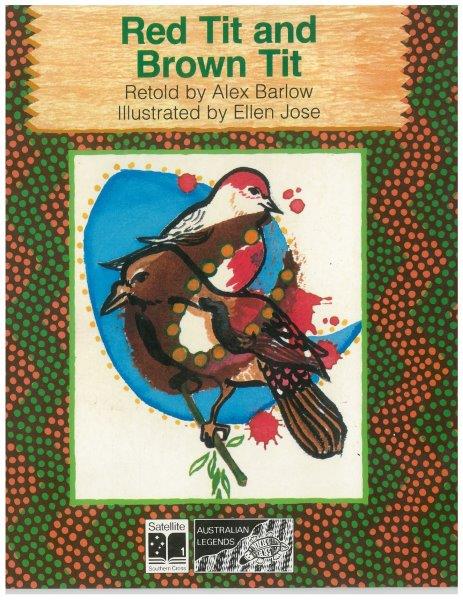Set in Boulia, a small west Queensland town, this story is a retelling of the story of the local Pitta Pitta people describing the way the two birds, the Red Tit, moo-na-tim-pi-ed-la and the Brown Tit, tin-er-ta came to be differentiated. The reteller, Alex Barlow, states that there is 'no record in books about Australian birds of the red-tit in Pitta- Pitta country today.'
Activities of food collection and cultivation, particularly of witooka, a pepper-flavoured root, are integrated into the text, as is the description of how Pitta-Pitta people catch emus in pits, which Red Tit imitates in the story.
Barlow’s retelling does not acknowledge illustrator Ellen Jose, a Torres Strait Islander descendant from Murray Damsay and Horn Islands. Ellen Jose’s illustrations of the birds initially depict them as outlines of human figures with similar bird heads. Brown Tit asks Red Tit to catch kangaroo, but she refuses. When she sees Brown Tit’s kangaroo meat, she wants some in exchange for her witooka, but he refuses her. Red Tit then traps and roasts emu but won’t share it with Brown Tit. Refusing to trade meat with each other they fight viciously, so that Red Tit ends up with blood red feathers on her head and breast, and Brown Tit has a flattened head and bumpy beak. The final illustration depicts them as plump little birds, contentedly reconciled on separate branches of a tree.
This is an expanded version of the Pitta-Pitta story originally recorded by W.E. Roth in the first volumes of his Queensland Aborigines in 1897. W.E. Roth’s reportage and photography of Aboriginal people became the subject of controversy in his time, of which Alex Barlow was probably not aware when he wrote this version of Red Tit and Brown Tit.
Early colonists often used European names for birds of quite unrelated species. Misrepresentations also occurred through translations of Indigenous languages. Hence, "tit" was commonly used for thornbills. From Jose's illustrations it seems that the Red Tit is the Red-capped robin. Her depiction of Brown Tit is not so accurate in the body of the bird, but the head and beak shows that it must be the Noisy Friarbird which has a range not too far away from Boulia (see Fraser and Gray and HANZAB v.6)
Series: Australian Legends

